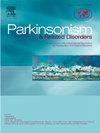周期性连续θ波爆发刺激在帕金森病中的作用
IF 3.4
3区 医学
Q2 CLINICAL NEUROLOGY
引用次数: 0
摘要
背景以往的研究表明,重复经颅磁刺激(rTMS)可以改善帕金森病(PD)的临床症状。连续脉冲刺激(cTBS)是一种完善的rTMS方案,影响大脑神经元,降低运动系统的兴奋性。目的探讨cTBS对PD患者运动症状改善的远期效果。方法将符合入选标准的患者非随机分为cTBS组和对照组。cTBS组每10周接受rTMS干预,而对照组仅接受抗帕金森病药物治疗以控制症状。研究周期近一年,数据分析时间为2024年3月至5月。采用线性混合模型使用统一帕金森病评定量表(UPDRS)第三部分分析主要结局。结果共有43名参与者完成了为期46周的研究。与对照组相比,cTBS组在第一次干预后UPDRS III表现出显著改善,并保持这一进展,直到最后随访,这与整体运动症状的变化相关。cTBS组H-Y评分明显降低,左旋多巴等效剂量(LED)无明显升高。结论cTBS可有效缓解PD的运动症状,针对左侧SMA的rTMS可能是一种可行且易于实施的非药物干预,可减缓PD的运动症状和生活质量的进行性下降,为PD的治疗提供新的选择。本文章由计算机程序翻译,如有差异,请以英文原文为准。
Effect of periodical continuous theta burst stimulation in Parkinson's disease
Background
Previous studies have demonstrated that repetitive transcranial magnetic stimulation (rTMS) can improve clinical symptoms of Parkinson's disease (PD). Continuous theta-burst stimulation (cTBS) is a well-established rTMS protocol that affects brain neurons, reducing the excitability of the motor system.
Objectives
This study aims to explore the long-term effects of cTBS on improvement of movement symptoms in patients with PD.
Methods
Patients who met the inclusion criteria were non-randomly assigned to either the cTBS group or control group. The cTBS group received rTMS interventions every 10 weeks, while the control group was treated solely with anti-Parkinson's medications for symptom management. The study cycle lasted nearly one year, with data analysis conducted from March to May 2024. Linear mixed models were employed to analyze the primary outcome using the Unified Parkinson's Disease Rating Scale (UPDRS) Part III.
Results
A total of 43 participants completed the 46-week study. The cTBS group demonstrated significant improvement in UPDRS III compared to the control group after the first intervention, maintaining this progress until the final follow-up, which correlated with changes in overall motor symptoms. Additionally, the cTBS group showed a significant decrease in H-Y scale, while the levodopa equivalent dose (LED) did not increase significantly.
Conclusions
These findings implicated that cTBS can effectively alleviate motor symptoms of PD, and rTMS targeting left SMA may be a feasible and easy-to-implement non-drug intervention to slow the progressive decline in motor symptoms and quality of life in PD, providing a new option for PD treatment.
求助全文
通过发布文献求助,成功后即可免费获取论文全文。
去求助
来源期刊

Parkinsonism & related disorders
医学-临床神经学
CiteScore
6.20
自引率
4.90%
发文量
292
审稿时长
39 days
期刊介绍:
Parkinsonism & Related Disorders publishes the results of basic and clinical research contributing to the understanding, diagnosis and treatment of all neurodegenerative syndromes in which Parkinsonism, Essential Tremor or related movement disorders may be a feature. Regular features will include: Review Articles, Point of View articles, Full-length Articles, Short Communications, Case Reports and Letter to the Editor.
 求助内容:
求助内容: 应助结果提醒方式:
应助结果提醒方式:


